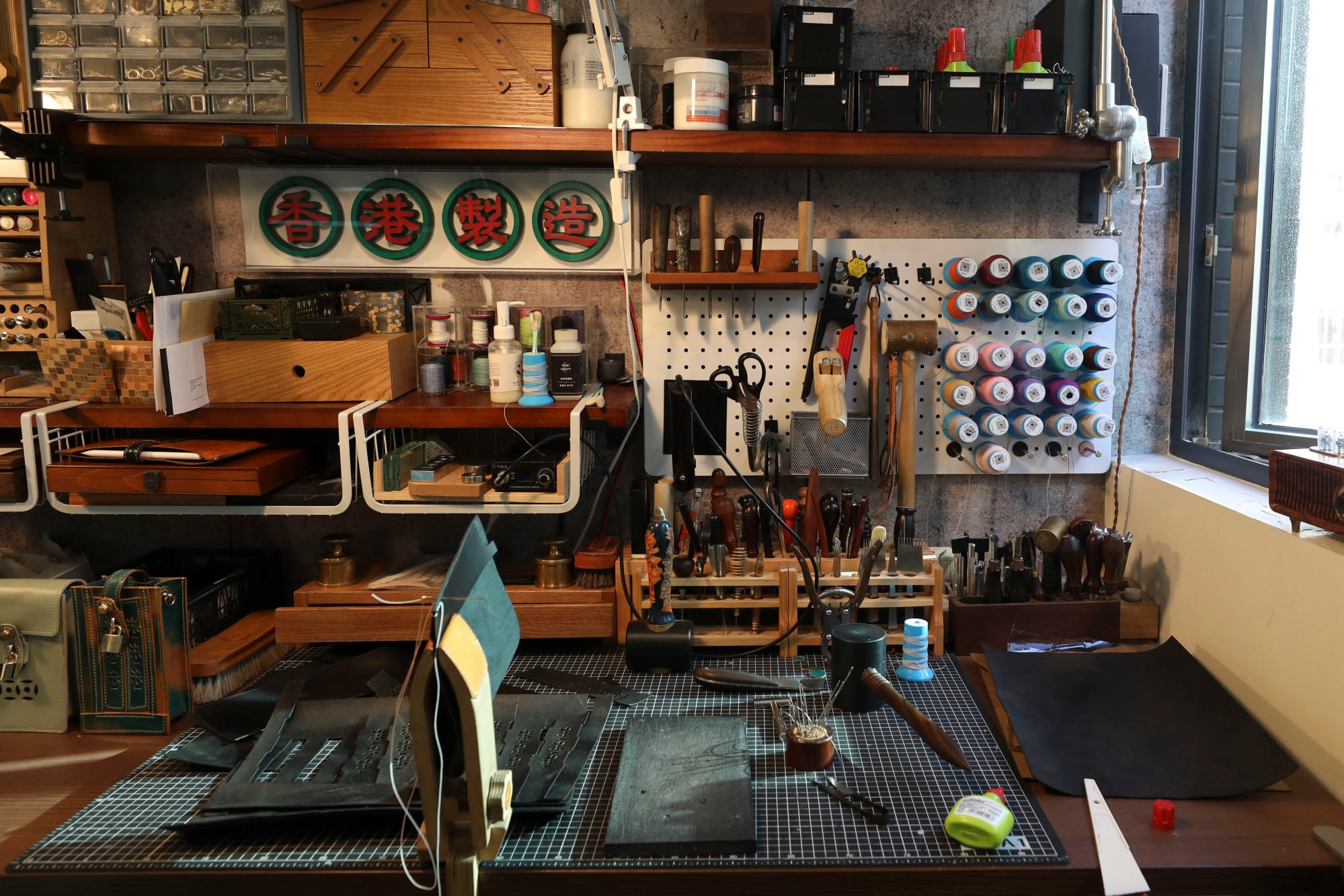Kwok’s wife, Violet, is there as well. She works in the hospitality industry but occasionally helps out at the studio which, on a recent afternoon in November, is bathed in warm sunlight.

Stealing the show in this creative hub is Kwok’s workbench. Cluttered with tools of his trade, from knives and mallets to chunky brass stamps used to emboss personalised names and messages, it screams organised chaos. Spools of thread hang in neat rows on a wall.
‘Tea shirts’? Hong Kong indie fashion label Yat Pit’s love of local culture
‘Tea shirts’? Hong Kong indie fashion label Yat Pit’s love of local culture
Taking up a big chunk of bench space is a leather cutting machine from South Korea, while rolls of the material stand to attention in a box. Another crate holds leather scraps.
“I try to keep waste to a minimum,” Kwok says.
He sources leather from Hong Kong’s Sham Shui Po neighbourhood and Japan. The good stuff, expensive marbled leather from Italy, is wrapped in protective paper and kept in a separate compartment.
“There are only four places in the world that supply this shell cordovan leather,” Kwok says, unravelling a sheet of the premium material that’s known for its lustrous appearance. It’s luxe and glossy, begging to be touched. But don’t – it stains easily, he says.
It’s not surprising that Kwok imports from Italy. The country’s connection to leather is long and strong – people in ancient Roman times, as in ancient Greece and Egypt, were making goods from it thousands of years ago.
This Italian leather is made from horse hide, Violet says. “It’s from the hip of a horse, the best part, which is why it’s not cheap.”

To preserve the leather, and keep it soft and supple, Kwok recommends customers apply a conditioning paste.
“This one is good,” he says, holding up Fiebing’s Golden Mink Oil. “It works just like a cream for a woman’s face.” The packaged tub is shipped from the United States.
Pulling up a swivel chair, Kwok demonstrates his craft, carefully cutting a customised piece of black leather that shimmers with subtle gold specks. “I added gold acrylic paint to give the leather a unique look.”
People order these handbags not only as a fashion accessory but because the design reminds them of their grandparents
Clients can customise items – bags, passport holders, luggage name tags, cardholders, key rings – by selecting their favourite colour palette for the leather and thread.
Crafting items is a labour of love, never a chore, Kwok says. It requires focus, patience and care to make sure the leather is not scratched – or flesh cut. The tools are sharp.
“We are prepared,” says Violet, opening a drawer packed with plasters.


In a world of cheap, mass-produced goods, it is inspiring to see a young creative hand crafting goods, and shaping a business, with quality control at their core.
Dressed in a flat cap, one gets the feeling Kwok has an old soul.
Before founding Nardos in 2021, he was a social worker with a non-governmental organisation, and occasionally returns there to host leather-making workshops for teenagers. Religion is a big part of his life – he met his wife at church. On his work bench is a wooden carving with the words, In God We Trust.

The name Nardos is a nod to his Christian faith. In the Bible, an expensive perfume made from sweet-scented Nardos flowers, also known as tuberose, was poured onto Jesus’ feet as a lavish gift.
The delicate flower’s image also appears on Nardos’ bags, the design resembling some of the carved patterns on the clunky folding metal gates that have been slowly vanishing in Hong Kong under the march of modernisation. The patterns are both pretty and practical: they allow light to filter through, and provide ventilation.
Kwok’s “light bulb moment” for a bag design based on the gates came in 2019. “One night I couldn’t sleep, and this idea jumped into my head, so I drew a design in my sketchbook.”

The prototype bag took about 40 hours to make and sits proudly on a shelf in the studio.
Today his bags are in demand, and while most customers are from Hong Kong, a fan base is growing in Japan. Orders also come from Taiwan and occasionally Canada.
“I take the [promotional] photos myself, sometimes up to 100 shots for each item until I get the perfect one,” he says. Product shooting tutorials on YouTube helped him refine his skills.
What Kwok also does, and which factories fail to do, is stitch sentiment into his work.
“I’m not just thinking about how to sell a product,” he says. “I’m also selling a memory of the past.”
For many customers, Nardos’ leather goods stir childhood memories. “People order these handbags not only as a fashion accessory but because the design reminds them of their grandparents.”

The iron gate, he says, has layered meaning, symbolising the strength and resilience of Hong Kong people.
First used in Hong Kong broadcaster RTHK’s television series Below The Lion Rock, this is a reference to Lion Rock, the mountain in the Kowloon Hills that has become a symbol of the city’s spirit of hard work.
“The iron gate has undoubtedly become a nostalgic symbol for Hong Kong people in recent years,” Kwok says. “We have experienced ups and downs – and witnessed great change. The strong gates uphold our core values.”
